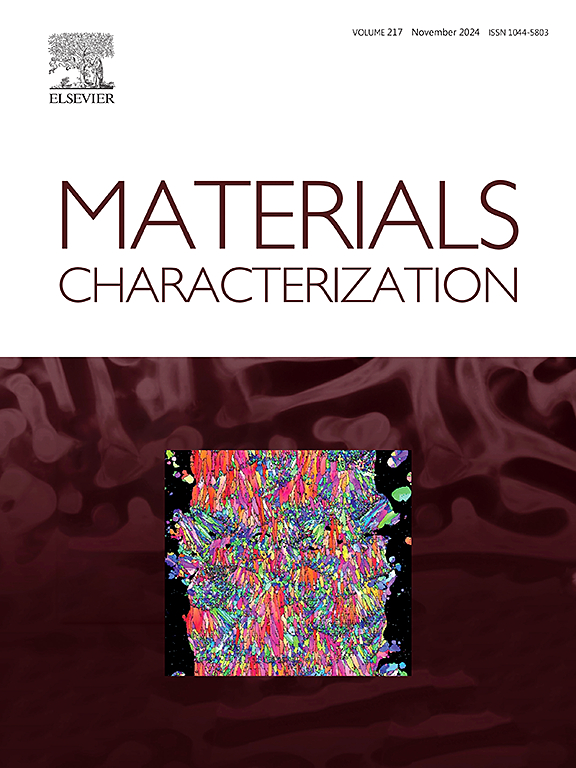Athermally-enhanced recovery and recrystallization behaviors in cold-rolled pure tungsten via electric current stressing
IF 4.8
2区 材料科学
Q1 MATERIALS SCIENCE, CHARACTERIZATION & TESTING
引用次数: 0
Abstract
In this study, athermally-enhanced recovery and recrystallization behaviors were introduced in the pure tungsten at 4.8 × 104 A/cm2 for 1 h at a processing temperature of 235 °C (0.14 Tm), which was much lower than the conventional heat treatment of approximately 1500 °C. The metallurgical behavior induced by electric current stressing for inducing annealing phenomena was investigated using electron backscatter electron diffraction (EBSD) to explain the observed variations in the mechanical and electrical properties. The electric current stressing induced softening of the pure tungsten with a maximum extent of 22.4 %, which was proposed to be attributed to the synergistic recovery and recrystallization. The current-enhanced recovery behavior can be evidenced by the transformation of subboundaries to low-angle grain boundaries, and the current-enhanced recrystallization behavior can be evidenced by the grain refinement, subboundary transformation to high-angle grain boundaries, formation of annealing rotated Cube texture, and annihilation of dislocations. The electrical resistivity increase with a maximum extent of 29.5 % was explained by the increasing grain boundary density as a result of recrystallization. The electrical annealing can achieve the same effect as conventional heat treatment, exhibiting higher efficiency in reducing the micro-hardness of pure tungsten at a lower processing temperature. Pronounced athermal effects of the electro-treatment were highlighted by the comparisons of microstructures and properties with a designed thermal benchmark experiment using the same thermal history as the electro-treatment to provide solid experimental evidence. The electrical annealing is proposed as a potential alternative to conventional heat treatment featuring more energy-efficient and time-saving for green manufacturing.

电流应力作用下冷轧纯钨的热增强恢复和再结晶行为
在本研究中,纯钨在4.8 × 104 A/cm2下,在235℃(0.14 Tm)的处理温度下进行了1 h的热增强恢复和再结晶行为,该温度远低于常规热处理的约1500℃。利用电子背散射电子衍射(EBSD)研究了电流应力诱导退火现象的冶金行为,以解释观察到的力学和电学性能的变化。电流应力诱导纯钨的软化最大程度为22.4%,这是由于钨的恢复和再结晶的协同作用。电流增强的恢复行为表现为亚晶界向低角度晶界的转变,电流增强的再结晶行为表现为晶粒细化、亚晶界向高角度晶界的转变、退火旋转立方体织构的形成和位错的湮灭。电阻率的最大增加幅度为29.5%,这是由于再结晶导致晶界密度增加所致。电退火可以达到与常规热处理相同的效果,在较低的加工温度下降低纯钨的显微硬度表现出更高的效率。通过使用与电处理相同的热历史设计的热基准实验对微观结构和性能进行比较,突出了电处理的明显非热效应,以提供坚实的实验证据。电退火被认为是传统热处理的潜在替代品,具有更节能和节省时间的绿色制造。
本文章由计算机程序翻译,如有差异,请以英文原文为准。
求助全文
约1分钟内获得全文
求助全文
来源期刊

Materials Characterization
工程技术-材料科学:表征与测试
CiteScore
7.60
自引率
8.50%
发文量
746
审稿时长
36 days
期刊介绍:
Materials Characterization features original articles and state-of-the-art reviews on theoretical and practical aspects of the structure and behaviour of materials.
The Journal focuses on all characterization techniques, including all forms of microscopy (light, electron, acoustic, etc.,) and analysis (especially microanalysis and surface analytical techniques). Developments in both this wide range of techniques and their application to the quantification of the microstructure of materials are essential facets of the Journal.
The Journal provides the Materials Scientist/Engineer with up-to-date information on many types of materials with an underlying theme of explaining the behavior of materials using novel approaches. Materials covered by the journal include:
Metals & Alloys
Ceramics
Nanomaterials
Biomedical materials
Optical materials
Composites
Natural Materials.
 求助内容:
求助内容: 应助结果提醒方式:
应助结果提醒方式:


